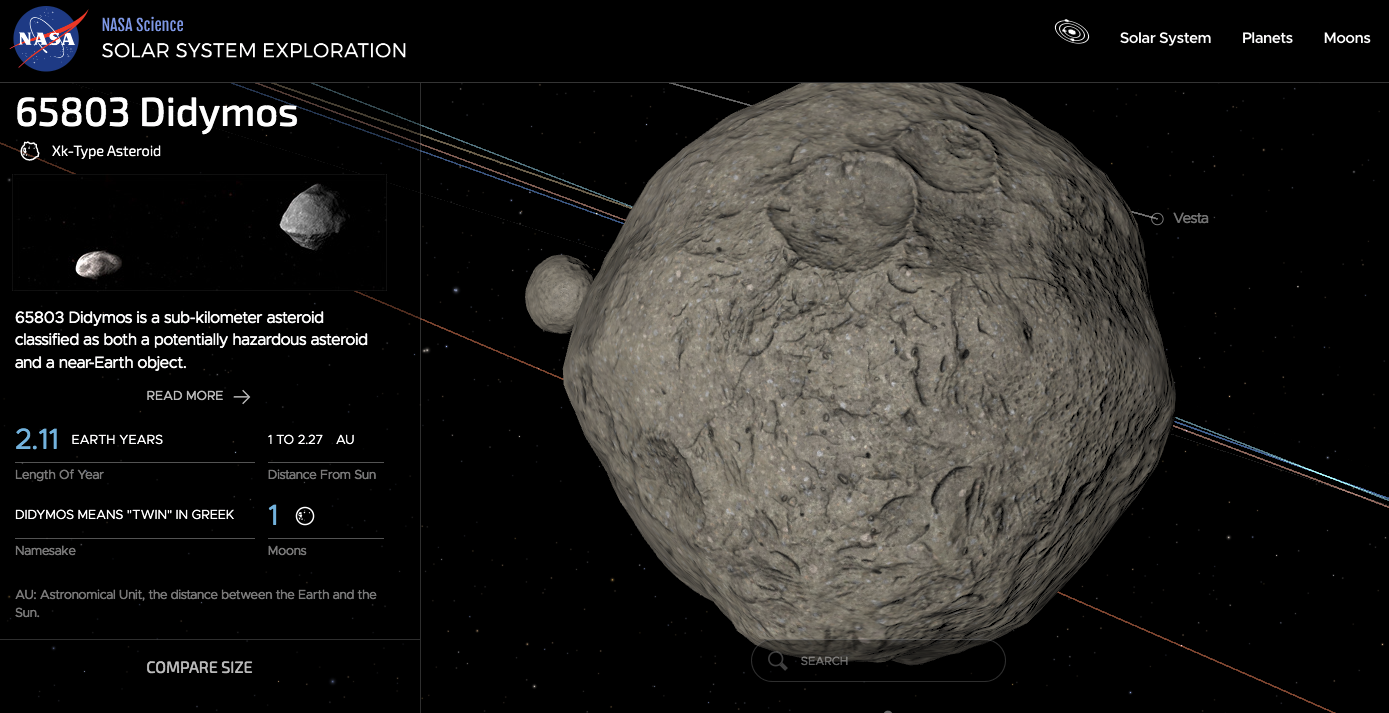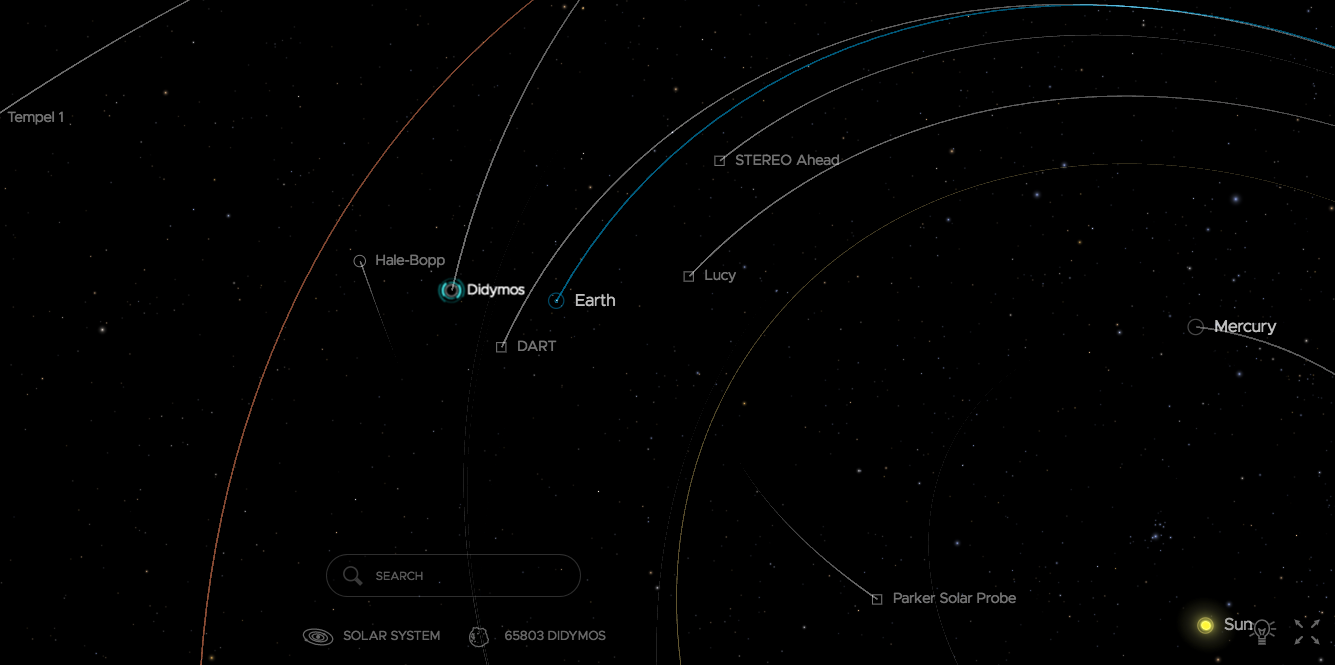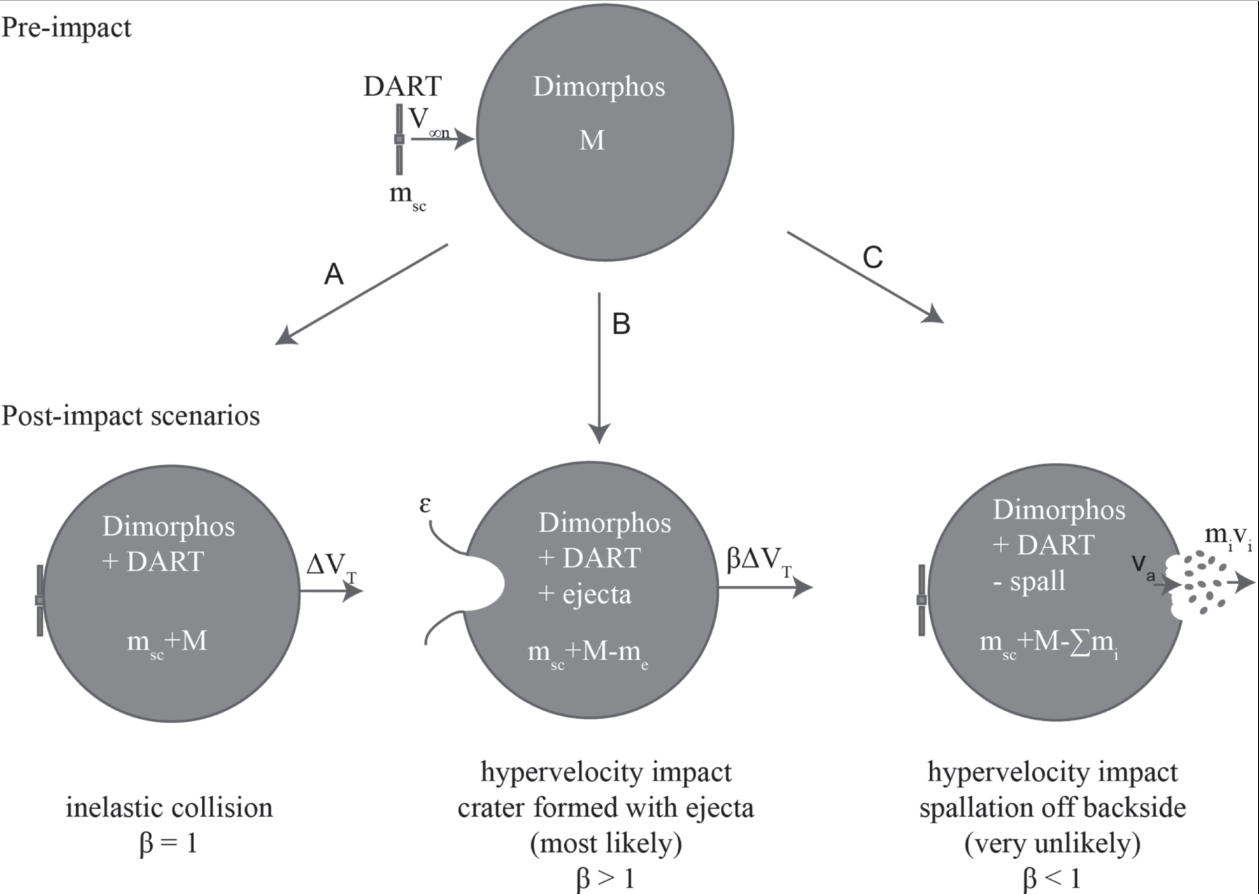It looks like you're using an Ad Blocker.
Please white-list or disable AboveTopSecret.com in your ad-blocking tool.
Thank you.
Some features of ATS will be disabled while you continue to use an ad-blocker.
share:
So much going on, missed this somehow. I always thought this capability was theoretical but sounds like NASA is about to give it a go.
Trying it on an asteroid Dimorphos that has no potential to hit the earth.
www.nasa.gov...
Trying it on an asteroid Dimorphos that has no potential to hit the earth.
www.nasa.gov...
NASA’s Double Asteroid Redirection Test (DART), the world’s first mission to test technology for defending Earth against potential asteroid or comet hazards, will impact its target asteroid—which poses no threat to Earth—at 7:14 p.m. EDT on Monday, Sept. 26.
Among other activities, NASA will host a televised briefing beginning at 6 p.m. on Sept. 26 from the Johns Hopkins Applied Physics Laboratory (APL) in Laurel, Maryland. APL is the builder and manager of the DART spacecraft for NASA.
This test will show a spacecraft can autonomously navigate to a target asteroid and intentionally collide with it to change the asteroid’s motion in a way that can be measured using ground-based telescopes. DART will provide important data to help better prepare for an asteroid that might pose an impact hazard to Earth, should one ever be discovered.
originally posted by: Axios
a reply to: putnam6
Super cool! I hope this doesn't turn into one of those situations where our attempt to redirect an incoming comet/asteroid goes awry and puts the object on a direct path with the earth.
FWIW Dimorphus DART'S target is the "moon" of Didymos which on the graphic here does say
65803 Didymos is a sub-kilometer asteroid classified as both a potentially hazardous asteroid and a near-Earth object.
solarsystem.nasa.gov...

which contradicts further reading
Didymos
Asteroid Didymos and its small moonlet Dimorphos make up what’s called a binary asteroid system – meaning the small moon (Dimorphos) orbits the larger body (Didymos).
The two asteroids are not a threat to Earth, but because they do pass relatively close to the Earth, they were chosen as the target for NASA’s Double Asteroid Redirection Test (DART) mission – the agency's first mission to test planetary defense technology. This technology could one day be used to deflect hazardous asteroids on a collision course with Earth.
I would assume since the orbit is past earth all its momentum will carry it away from us till it potentially returns depending on how large it's orbit is?

edit on 24-8-2022 by putnam6 because: (no reason given)
a reply to: putnam6
Thanks for the infographics. I like the second one plotting their courses.
With Dimorphos orbitings the larger body, could there not be a situation where the impact occurs flinging the smaller object in the direction of earth?
Probably not since from what I read seems to indicate a course change of approx. 1%
Thanks for the infographics. I like the second one plotting their courses.
With Dimorphos orbitings the larger body, could there not be a situation where the impact occurs flinging the smaller object in the direction of earth?
Probably not since from what I read seems to indicate a course change of approx. 1%
originally posted by: Axios
a reply to: putnam6
Thanks for the infographics. I like the second one plotting their courses.
With Dimorphos orbitings the larger body, could there not be a situation where the impact occurs flinging the smaller object in the direction of earth?
Probably not since from what I read seems to indicate a course change of approx. 1%
No, it's not likely at but it's interesting to me that it looks like it intersects earth's orbital plane for an extended period of time much more than some of the other near-earth asteroids that intersect our orbital plane at different angles
a reply to: putnam6
I thought they would have tried something more innovative than just smashing a satellite into the object. I remember watching popular mechanics and such that had ideas to use lasers to heat up one part object or paint to increase it reflectivity..
I thought they would have tried something more innovative than just smashing a satellite into the object. I remember watching popular mechanics and such that had ideas to use lasers to heat up one part object or paint to increase it reflectivity..
originally posted by: Axios
a reply to: putnam6
I thought they would have tried something more innovative than just smashing a satellite into the object. I remember watching popular mechanics and such that had ideas to use lasers to heat up one part object or paint to increase it reflectivity..
Purely speculation on my part, but it might be the only technology that can be used on our platforms and/or it was the only one available for the launch window needed for an intercept.

edit on 24-8-2022 by putnam6 because: (no reason given)
Sounds like the beginning of a bad B movie.
Scientists test a new asteroid deflection system by changing the movement of an insignificant asteroid. Unfortunately, that asteroid collides with another asteroid which hits a larger asteroid which sends the larger asteroid on a collision course with the Moon. The Reptiles living on the Moon interpret this as an attack. They destroy the larger asteroid and launch a full scale invasion on Earth.
The movie has a happy ending though. The Reptilians kill our leaders, reduce our technology back to the 1800's, and warn us to never venture into space again.
Scientists test a new asteroid deflection system by changing the movement of an insignificant asteroid. Unfortunately, that asteroid collides with another asteroid which hits a larger asteroid which sends the larger asteroid on a collision course with the Moon. The Reptiles living on the Moon interpret this as an attack. They destroy the larger asteroid and launch a full scale invasion on Earth.
The movie has a happy ending though. The Reptilians kill our leaders, reduce our technology back to the 1800's, and warn us to never venture into space again.
FWIW let's freak out yet...this isn't Space 1999
It's not gonna blow up Dimorphus or create chunks of it, it's only 530 feet and if by some crazy happenstance it was on a direct collision course with earth it would likely disintegrate completely or skip and bounce off the atmosphere.
www.nasa.gov...
and lastly...
iopscience.iop.org...

It's not gonna blow up Dimorphus or create chunks of it, it's only 530 feet and if by some crazy happenstance it was on a direct collision course with earth it would likely disintegrate completely or skip and bounce off the atmosphere.
www.nasa.gov...
The DART demonstration has been carefully designed. Didymos's orbit does not intersect Earth's at any point in current predictions, and the impulse of energy that DART delivers to Dimorphos is low and cannot disrupt the asteroid. The mass of the DART spacecraft at the time of its kinetic impact with Dimorphos is expected to be roughly 550 kilograms (1,210 pounds), depending on the amount of fuel used by the spacecraft prior to the kinetic impact event. The mass of Dimorphos has not been directly measured, but using assumptions for the asteroid’s density and size, the mass of Dimorphos is estimated as roughly 5 billion kilograms. Additional detailed information about the Didymos binary asteroid system and DART’s planned kinetic impact geometry can be found in this publication. Furthermore, the change in Dimorphos's orbit by DART’s kinetic impact is designed to bring its orbit slightly closer to Didymos. The DART mission is a demonstration of a capability to respond to a potential asteroid impact threat, should one ever be discovered.
and lastly...
iopscience.iop.org...
DART is a spacecraft designed to impact an asteroid as a test of technology. DART’s target asteroid is NOT a threat to Earth. This asteroid system is a perfect testing ground to see if intentionally crashing a spacecraft into an asteroid is an effective way to change its course, should an Earth-threatening asteroid be discovered in the future. While no known asteroid larger than 140 meters in size has a significant chance to hit Earth for the next 100 years, only about 40 percent of those asteroids have been found as of October 2021.

That is awesome until someone f*cks up and knocks an asteroid into earth.
Or does it with intent to destroy. Or to blackmail the whole world into doing it’s wishes. While they hang out off world with champagne and caviar to celebrate when the main event kicks off.
The mind boggles
a reply to: putnam6
Or does it with intent to destroy. Or to blackmail the whole world into doing it’s wishes. While they hang out off world with champagne and caviar to celebrate when the main event kicks off.
The mind boggles
a reply to: putnam6
I'm all for planetary defense systems. I'm glad this project is getting somewhere at least. We have a lot of work to do to keep humanity alive for the
next 1000 years.
new topics
-
Nigel Farage now the Most Favoured UK Politician
Regional Politics: 1 hours ago -
Little Johnny and Larry should team up
General Chit Chat: 7 hours ago -
Will Us use alien technology to fight in ww3?
World War Three: 8 hours ago
top topics
-
Elon Says It’s ‘Likely’ He Buys Tanking MSNBC
Political Ideology: 16 hours ago, 16 flags -
Montelukast affects brain, caused 5 year old to attempt suicide
Medical Issues & Conspiracies: 17 hours ago, 15 flags -
Little Johnny and Larry should team up
General Chit Chat: 7 hours ago, 5 flags -
Shane Gillis commercial
Jokes, Puns, & Pranks: 14 hours ago, 4 flags -
Will Us use alien technology to fight in ww3?
World War Three: 8 hours ago, 1 flags -
Nigel Farage now the Most Favoured UK Politician
Regional Politics: 1 hours ago, 1 flags
active topics
-
Nigel Farage now the Most Favoured UK Politician
Regional Politics • 3 • : gortex -
Well we know Putins ICBMs won't fail in their silos
World War Three • 179 • : andy06shake -
Will Us use alien technology to fight in ww3?
World War Three • 10 • : andy06shake -
Why isn't Psychiatry involved?
Social Issues and Civil Unrest • 13 • : ADVISOR -
WATCH LIVE: US Congress hearing on UFOs, unidentified anomalous phenomena
Aliens and UFOs • 152 • : Lazy88 -
Biden's "Reckless" Decision To Escalate Russia-Ukraine War
World War Three • 123 • : BedevereTheWise -
Elon Says It’s ‘Likely’ He Buys Tanking MSNBC
Political Ideology • 74 • : andy06shake -
Montelukast affects brain, caused 5 year old to attempt suicide
Medical Issues & Conspiracies • 10 • : DeadlyStaringFrog -
Jaguar Rebrand Video Causes "WTF?" Moment - Seriously Weird
Automotive Discussion • 21 • : Athetos -
Well, here we go red lines crossed Biden gives the go ahead to use long range missiles
World War Three • 329 • : Imhere

